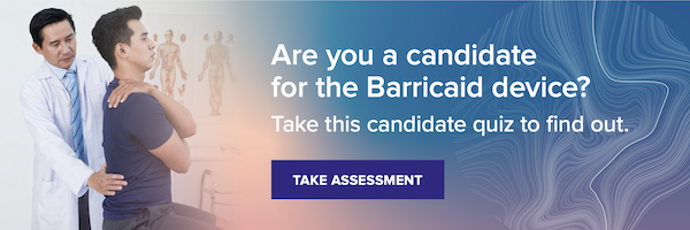
If you’ve already had a lumbar discectomy to relieve symptoms resulting from a herniated disc, the last thing you want or expect is to end up back at square one. Although lumbar discectomy surgery generally has very high success rates and around 84 percent of patients achieve good results, reherniation and reoperation are still possible.
Wondering if you need a second surgery to correct a reherniated lumbar disc? If you’re struggling (or you think you might be struggling) with recurrent lumbar disc herniation and think you may need another surgery, read more to learn the best way forward.
Understanding Your Risk of Reherniation
Reherniation, also referred to as recurrent disc herniation, is the most common complication that occurs after lumbar discectomy surgery. Approximately 7-18 percent of lumbar discectomy patients experience reherniation after their first surgery, with certain lifestyle risks increasing the odds of recurrence, such as:
- Sedentary lifestyle: Discectomy patients living a sedentary lifestyle are more likely to experience a poor outcome following their procedure because our muscles become tense and stiff when they remain inactive for long periods of time.
- High body mass index (BMI): The higher a patient’s BMI is, the more likely they are to require a revision procedure. A study of 226 patients found that reherniation risk increases significantly in morbidly obese patient populations.
- Improper heavy lifting: Heavy lifting—especially without using the proper technique—puts increased pressure on our spinal discs and can lead to reinjury following lumbar discectomy surgery.
- Tobacco usage: Using tobacco products increases the risk of reherniation after lumbar discectomy. A study revealed that patients who were smoking at the time of surgery had a 50 percent higher recurrence rate compared to non-smokers.
- Diabetes diagnosis: Research shows that diabetic patients have a higher risk of reherniation. According to one study, patients with uncontrolled diabetes have twice the recurrence rate after discectomy as those without the condition.
The amount of disc material removed during your first discectomy also comes into play when it comes to reherniation rates. During your discectomy, your spine surgeon must determine whether to perform a limited or aggressive discectomy. Limited discectomy involves only removing free disc material outside the disc, whereas in an aggressive discectomy, the surgeon also removes any disc material from inside the disc.
How does this relate to reherniation? There are pros and cons to both approaches, but limited discectomies have a higher risk of reherniation when compared to more aggressive removal of disc fragments. However, aggressive discectomy has its trade-offs too, as removing more tissue can result in a loss of disc height, or even disc collapse over time that can cause stiffness, pain, and instability.
With all that said, the single biggest risk factor is the size of the hole(s) present in your lumbar herniated disc. Patients with large holes in their treated disc—which account for around 30 percent of the lumbar discectomy population—have a much greater likelihood of symptoms coming back, with nearly a one in four chance of experiencing reherniation after their initial surgery.
Determining the Need for Repeat Surgery
Nearly 80 percent of patients with recurrent lumbar disc herniation will require repeat surgery to alleviate symptoms, such as shooting pain in the leg (sciatica), tingling and numbness, difficulty lifting your foot (foot drop), and loss of mobility. Roughly two-thirds of those reoperations are due to reherniation of the same disc after lumbar discectomy.
However, repeat operations to address a second lumbar disc herniation often aren’t as successful as the first surgery. Some research even reveals patients had 25 percent less improvement in function after a second surgery compared to their initial procedure. That’s why minimizing lifestyle risks is so essential in order to protect your spine to (hopefully) prevent reherniation following your first surgery.
Only your doctor can make a recommendation as to whether or not it makes sense to pursue repeat lumbar discectomy surgery to relieve symptoms caused by a recurrent disc herniation. Consult with your spine surgeon for an opportunity to ask any questions you may have, explore your treatment options, and ultimately determine whether another discectomy is the best approach for relief from sciatica pain.
During your appointment, your spine surgeon will also likely perform a physical exam and new radiographic image testing, such as X-rays, computed tomography (CT) scans, and/or magnetic resonance imaging (MRI) scans. This will ultimately help to determine the level and severity of the reherniation, as well as the best treatment approach.
Preventing Reherniation with Barricaid
In cases like Diego’s, sometimes reherniation is unavoidable. Fortunately, Diego’s doctor was well versed in the latest spine surgery innovations and recommended using the Barricaid device to close large holes during lumbar discectomy, with the hope of preventing another future reherniation.
As a lifelong athlete, it was also critical that Diego maintain his mobility. Today, after a lumbar discectomy with Barricaid, you’ll find him running marathons and climbing mountains.
“For someone who wants to stay active, Barricaid is the choice,” Diego explained. “While climbing, the last thing on my mind—even with a 60-pound backpack—is any concern about a reherniation or return of back pain.”
If you do move forward with another lumbar discectomy, speak with your surgeon to learn whether you’re a candidate for Barricaid like Diego. Implanting the Barricaid device during a repeat discectomy helps to greatly reduce the risk of reherniation for patients with large holes in the disc, in addition to a third surgery. In fact, lumbar discectomy with Barricaid reduces the chance of reoperation by nearly 50 percent.
If you’ve already experienced reherniation and/or recurrence of sciatica symptoms—or even if you just think you might be struggling with another lumbar disc herniation—you don’t have to suffer in silence. Take the first step toward finally getting your life back for good and never looking back. Learn whether you're a candidate for Barricaid.
While this blog is meant to provide you with information you need to make an informed decision about your treatment options, it is not intended to replace professional medical care or provide medical advice. If you have any questions about the Barricaid, please call or see your doctor, who is the only one qualified to diagnose and treat your spinal condition. As with any surgical procedure, you should select a doctor who is experienced in performing the specific surgery that you are considering.
If you have any questions about the Barricaid, you may ask your doctor. For additional information, please visit www.barricaid.com. For complete risk-benefit information: www.barricaid.com/instructions.
While this blog is meant to provide you with the information you need to make an informed decision about your treatment options, it is not intended to replace professional medical care or provide medical advice. If you have any questions about the Barricaid, please call or see your doctor, who is the only one qualified to diagnose and treat your spinal condition. As with any surgical procedure, you should select a doctor who is experienced in performing the specific surgery that you are considering.
If you have any questions about the Barricaid, you may ask your doctor. For additional information, please visit www.barricaid.com. For complete risk-benefit information: www.barricaid.com/instructions-for-use.
References
1 Eric Elowitz, “Microdiscectomy Spine Surgery: Risks, Complications, and Success Rates,” Spine Health, Veritas Health, 2016, https://www.spine-health.com/treatment/back-surgery/microdiscectomy-spine-surgery-risks-complications-and-success-rates.
2 Eugene J. Carragee et al, "A Prospective Controlled Study Of Limited Versus Subtotal Posterior Discectomy: Short-Term Outcomes In Patients With Herniated Lumbar Intervertebral Discs And Large Posterior Annular Defect," Spine 31, no. 6 (2006): 653-657, doi:10.1097/01.brs.0000203714.76250.68.
3 Daniel D. Bohl et al, “Does Greater Body Mass Index Increase the Risk for Revision Procedures Following a Single-Level Minimally Invasive Lumbar Discectomy?” Spine 41, no. 9 (2016): 816-821, doi: 10.1097/BRS.0000000000001340.
4 Mesut E. Yaman et al, “Factors That Influence Recurrent Lumbar Disc Herniation,” Hong Kong Medical Journal 23, no. 3 (2017): 258-263, doi: 10.12809/hkmj164852.
5 Ibid.
6 William C. Watters and Matthew J. McGirt, "An Evidence-Based Review Of The Literature On The Consequences Of Conservative Versus Aggressive Discectomy For The Treatment Of Primary Disc Herniation With Radiculopathy," The Spine Journal 9, no. 3 (2009): 240-257, doi:10.1016/j.spinee.2008.08.005.
7 Larry E. Miller et al, “Association of Annular Defect Width After Lumbar Discectomy With Risk of Symptom Recurrence and Reoperation: Systematic Review and Meta-Analysis of Comparative Studies,” Spine 43, no. 5 (2018): E308-E315, doi: 10.1097/BRS.0000000000002501.
8 Frederic Martens et al, “Patients at the Highest Risk for Reherniation Following Lumbar Discectomy in a Multicenter Randomized Controlled Trial,” JB & JS Open Access 3, no. 2 (2018): E0037, doi: 10.2106/JBJS.OA.17.00037.
9 Mark P. Arts, MD, PhD, et al, “Comparison of treatments for lumbar disc herniation Systematic review with network meta-analysis,” The Journal of Bone and Joint Surgery 98, no. 7 (2019), https://journals.lww.com/md-journal/fulltext/2019/02150/comparison_of_treatments_for_lumbar_disc.20.aspx#JCL-P-13
10 Robert Abdu et al, “Reoperation for Recurrent Intervertebral Disc Herniation In The Spine Patient Outcomes Research Trial: Analysis of Rate, Risk Factors and Outcomes,” Spine 42, no. 14 (2017): 1106-1114, doi: 10.1097/brs.0000000000002088.
11 Dante Leven et al, "Risk Factors For Reoperation In Patients Treated Surgically For Intervertebral Disc Herniation," The Journal Of Bone And Joint Surgery-American 97, no. 16 (2015): 1316-1325, doi:10.2106/jbjs.n.01287.
12 Peter D. Klassen et al, “Post-Lumbar Discectomy Reoperations That Are Associated with Poor Clinical and Socioeconomic Outcomes Can Be Reduced through Use of a Novel Annular Closure Device: Results from a 2-Year Randomized Controlled Trial,” ClinicoEconomics and Outcomes Research 10 (2018): 349-357, doi: 10.2147/CEOR.S164129.



Comments